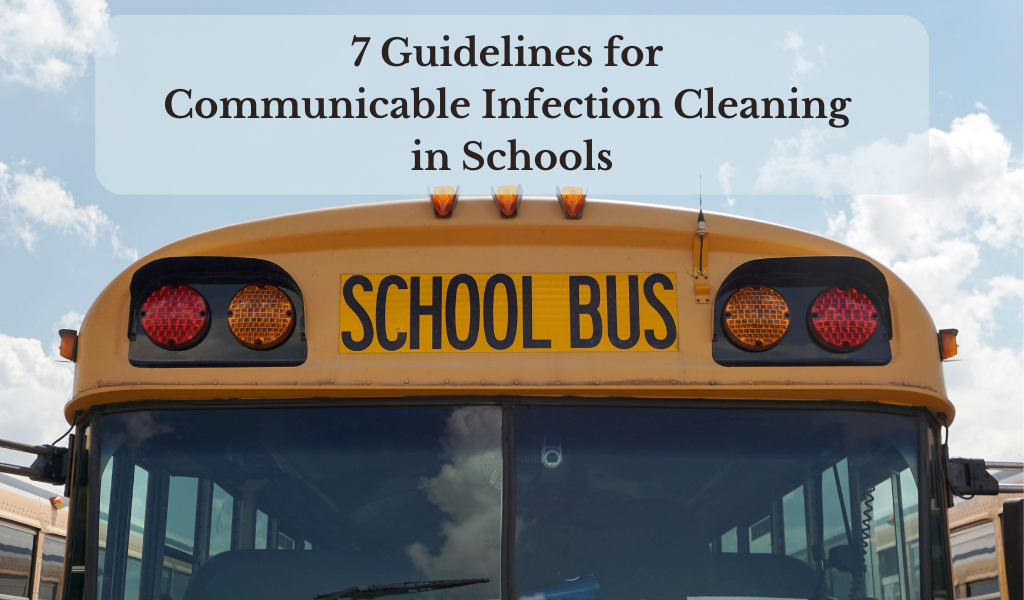Communicable infection and schools go together like ABC and 123. Here’s how to clean schools effectively and safely.
Any time you have a large group of people circulating through a space, you risk transmitting a communicable infection. This is true in office buildings, restaurants, churches, and retail shops. Where it comes up most frequently, however, is in schools.
Large high schools may have hundreds or thousands of students, and it’s not unusual for elementary and middle schools to have 20 or more students in each classroom. Pack that many people into a small, enclosed space, and it’s easy for an infection to spread. It’s such a common occurrence, in fact, that federal, state, and local government agencies all address the issue on their websites.
From the CDC, to the state of Maine, to the city of Albuquerque, New Mexico, you can find policies and procedures regarding the management of communicable infection outbreaks in schools. This is all very important information. For commercial cleaners and those responsible for cleaning in schools, however, the responsibilities and actions are slightly different.
If you’re ready to bring your cleaning organization to the next level, take advantage of a free call with Janitorial Manager to see how our software can make your janitorial operation more successful.

The 7 Guidelines for Communicable Infection Cleanup in Schools
1. Prevention. Prevention is always much easier to work toward than attempting to stop a communicable infection once it’s started making the rounds. You can’t ensure everyone is washing their hands properly or make sick kids and teachers stay home. What you can do is focus on disinfection and stop viruses and bacteria before they have a chance to establish themselves. There’s probably not much surprising at this point about disinfection in schools and office buildings. Make sure you frequently disinfect high-touch surfaces like door handles and faucets and follow the cleaning product’s directions for contact time.
2. Educate your team. There are plenty of educational opportunities out there that will help you and your team handle anything from bloodborne pathogens to biological hazard cleanup. The more you know about these, the more prepared you are to manage whatever may come up during the school year. Here are some courses and certifications that may be useful.
3. Wear appropriate PPE. If your team is sick, they can’t very well help with cleaning a school. That’s why taking the steps necessary to protect yourself and your employees is vital. What kind of PPE your team needs will depend on the specific communicable infection. Whether it’s a mask and gloves or a full-body covering, make sure you have the right equipment on hand. And ensure your team knows how to put on and remove PPE correctly.
4. Be mindful of cross-contamination. It’s easier than many of us realize to clean one surface and then spread those germs by using the same cloth to wipe down another surface. Similarly, mops, brooms, and brushes that aren’t properly cleaned can spread germs. You have a few options to help with this issue. Some cleaning companies find color-coded cleaning systems to be invaluable. It’s also helpful to clean your cleaning equipment and supplies. Not only will that help minimize the spread of a communicable infection, but it also helps your equipment last longer.
5. Use the appropriate disinfectant. Different infections may call for additional cleaning or specific disinfectants. Others may not require many changes at all. For example, the CDC recommends routine vacuuming of “carpeting, rugs, furniture, car seats, and other fabric-covered items” for lice since they can only live for a day or two once they are separated from the human head. Meanwhile, the EPA maintains a full list of antimicrobial products that are effective against common pathogens. You’re likely familiar with List N due to coronavirus, but they have 16 lists starting with List A for the EPA’s Registered Antimicrobial Products as Sterilizers and going through List Q for Disinfectants for Emerging Viral Pathogens (though they skip the letter I).
6. Follow the instructions. This one is so easy, yet so hard. For a disinfectant to be effective against a communicable infection, you have to follow the directions, whether or not it needs to be diluted, and the contact time the product needs to work.
7. Create a cleaning task list and make it easily accessible. No matter how many precautions you take or how well you follow the instructions on cleaning products, if your team doesn’t know what’s expected or what’s happening, you’ll work inefficiently and probably miss a lot of things. An easy way to avoid that confusion is to make sure you have a task list that everyone can access. Also, ensure everyone on your team knows what they are working on. You can do all of this manually and with notes, but it’s much easier to use janitorial software or take advantage of QR codes.
You may never be able to eliminate communicable infection issues in schools. But there is a lot you can do to slow the spread and even prevent a potential outbreak, and these guidelines are part of that plan.
Increase client satisfaction and customer retention rates with Janitorial Manager. Learn more today with a free discovery call!

